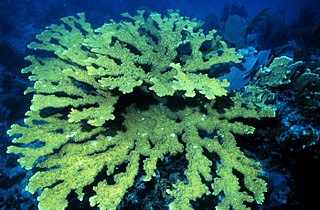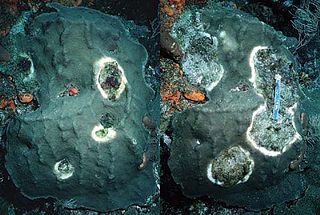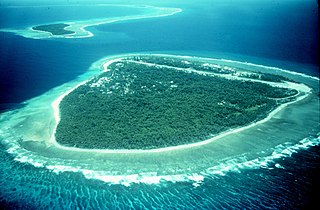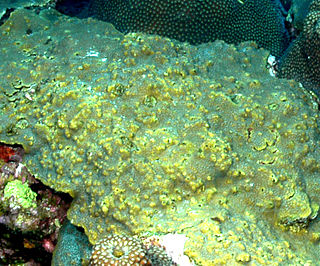A human pathogen is a pathogen that causes disease in humans.

Infection is the invasion of an organism's body tissues by disease-causing agents, their multiplication, and the reaction of host tissues to the infectious agents and the toxins they produce. Infectious disease, also known as transmissible disease or communicable disease, is illness resulting from an infection.

Scleractinia, also called stony corals or hard corals, are marine animals in the phylum Cnidaria that build themselves a hard skeleton. The individual animals are known as polyps and have a cylindrical body crowned by an oral disc in which a mouth is fringed with tentacles. Although some species are solitary, most are colonial. The founding polyp settles and starts to secrete calcium carbonate to protect its soft body. Solitary corals can be as much as 25 cm (10 in) across but in colonial species the polyps are usually only a few millimetres in diameter. These polyps reproduce asexually by budding, but remain attached to each other, forming a multi-polyp colony of clones with a common skeleton, which may be up to several metres in diameter or height according to species.
White plague may refer to:

Pillar coral is a hard coral found in the western Atlantic Ocean and the Caribbean Sea. It is the only species in the monotypic genus Dendrogyra. It is a digitate coral -that is, it resembles fingers or a cluster of cigars, growing up from the sea floor without any secondary branching. It is large and can grow on both flat and sloping surfaces at depths down to 20 m (65 ft). It is one of the few types of hard coral in which the polyps can commonly be seen feeding during the day.
The Aurantimonadaceae are a small family of marine bacteria. Six species are known. Aurantimonas coralicida causes a white plague in corals. Fulvimarina pelagi was isolated from seawater, and takes the form of nonmotile rods.

White band disease is a coral disease that affects acroporid corals and is distinguishable by the white band of dead coral tissue that it forms. The disease completely destroys the coral tissue of Caribbean acroporid corals, specifically elkhorn coral and staghorn coral. The disease exhibits a pronounced division between the remaining coral tissue and the exposed coral skeleton. These symptoms are similar to white plague, except that white band disease is only found on acroporid corals, and white plague has not been found on any acroporid corals. It is part of a class of similar disease known as "white syndromes", many of which may be linked to species of Vibrio bacteria. While the pathogen for this disease has not been identified, Vibrio carchariae may be one of its factors. The degradation of coral tissue usually begins at the base of the coral, working its way up to the branch tips, but it can begin in the middle of a branch.

Black band disease is a coral disease in which corals develop a black band. It is characterized by complete tissue degradation due to a pathogenic microbial consortium. The mat is present between apparently healthy coral tissue and freshly exposed coral skeleton.

Elkhorn coral is a prominent Caribbean reef-building coral, although current populations are still struggling to recover from white band disease outbreak. This species is structurally complex with many large branches. The coral structure resembles that of elk antlers. These branches create habitats for many other reef species, such as lobsters, parrot-fish, snapper shrimps and other reef fish. Elkhorn coral colonies are incredibly fast-growing, with an average growth rate of 5 to 10 cm per year and can eventually grow up to 3.7 m (12 ft) in diameter. The color of this coral species ranges from brown to a yellowish-brown as a result of the symbiotic zooxanthellae living inside the tissue of this coral species. Zooxanthellae are a type of algae which photosynthesize to provide the coral with nutrients. The zooxanthellae are also capable of removing waste products from the coral. Historically, the majority of elkhorn coral reproduction has occurred asexually; this occurs when a branch of the coral breaks off and attaches to the substrate, forming a new colony, known as fragmentation. The degree to which local stands reproduce by fragmentation varies across the Caribbean, but on average, 50% of colonies are the result of fragmentation rather than sexual reproduction. Sexual reproduction occurs once a year in August or September when coral colonies release millions of gametes by broadcast spawning.
Skeletal eroding band (SEB) is a disease of corals that appears as a black or dark gray band that slowly advances over corals, leaving a spotted region of dead coral in its wake. It is the most common disease of corals in the Indian and Pacific Oceans, and is also found in the Red Sea.

White pox disease, first noted in 1996 on coral reefs near the Florida keys, is a coral disease affecting Elkhorn coral throughout the Caribbean. It causes irregular white patches or blotches on the coral that result from the loss of coral tissue. These patches distinguish white pox disease from white band disease which produces a distinctive white band where the coral skeleton has been denuded. The blotches caused by this disease are also clearly differentiated from coral bleaching and scars caused by coral-eating snails. It is very contagious, spreading to nearby coral.

Yellow-band disease is a coral disease that attacks colonies of coral at a time when coral is already under stress from pollution, overfishing, and climate change. It is characterized by large blotches or patches of bleached, yellowed tissue on Caribbean scleractinian corals.

Human impact on coral reefs is significant. Coral reefs are dying around the world. Damaging activities include coral mining, pollution, overfishing, blast fishing, the digging of canals and access into islands and bays. Other dangers include disease, destructive fishing practices and warming oceans. Factors that affect coral reefs include the ocean's role as a carbon dioxide sink, atmospheric changes, ultraviolet light, ocean acidification, viruses, impacts of dust storms carrying agents to far-flung reefs, pollutants, algal blooms and others. Reefs are threatened well beyond coastal areas. Climate change, such as warming temperatures, causes coral bleaching, which if severe kills the coral.

Orbicella faveolata, commonly known as mountainous star coral, is a colonial stony coral in the family Merulinidae. It is native to the Caribbean Sea and the Gulf of Mexico and is listed as "endangered" by the International Union for Conservation of Nature. This species was formerly known as Montastraea faveolata.

Orbicella franksi, commonly known as boulder star coral, is a colonial stony coral in the family Merulinidae. It is native to shallow waters in the Caribbean Sea, the Gulf of Mexico, the Bahamas, Bermuda and Florida, and is listed as a "vulnerable species" by the International Union for Conservation of Nature.

One of the marine ecosystems found in the Virgin Islands are the coral reefs. These coral reefs can be located between the islands of St. Croix, St. Thomas, and St. John. These coral reefs have an area of 297.9 km2, along with other marine habitats that are in between. The way these coral reefs grow are by coral larvae swimming freely and attaching themselves to hard surfaces around the islands and start to develop a skeleton on the outside of their skin to protect themselves from predators but also allow a new place for other coral larvae to attach to and grow on. These corals can form into three different structures; fringing reefs, which are reefs that are close to the shore, barrier reefs, which are reefs that are alongside the shore and is separated by deep water, and an atoll reef which is a coral reef that circles a lagoon or body of water.
Thalassotalea loyana is a bacterium from the genus of Thalassotalea. Thalassomonas loyana can cause white plague disease in the coral Favia favus.














